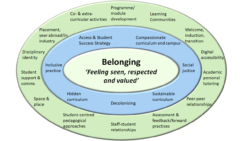Developing belonging
How to develop a sense of belonging
Belonging is seen as crucial in supporting student success at the University of Leeds. The graphic on this page is an attempt to illustrate some of the areas of strategy and student education practice that intersect and can contribute to students’ feelings of belonging during their time at Leeds.
 In the centre circle sits belonging, and the circle that surrounds this highlights university strategy and values and some strategic aims (compassionate campus and curriculum, social justice, inclusive practice, decolonising, hidden curriculum, sustainable curriculum) that are linked to achieving belonging. The outer circle identifies some areas of student education practice in which we need to consider best practice for ensuring students feel seen, respected and valued. While this graphic may not include every strategic aim or area of practice, it gives a sense of how different areas of work interconnect and can contribute to feelings of belonging in our students. If we are mindful of ensuring students feel seen, respected and valued in each area of work, this has the potential to make a big difference.
In the centre circle sits belonging, and the circle that surrounds this highlights university strategy and values and some strategic aims (compassionate campus and curriculum, social justice, inclusive practice, decolonising, hidden curriculum, sustainable curriculum) that are linked to achieving belonging. The outer circle identifies some areas of student education practice in which we need to consider best practice for ensuring students feel seen, respected and valued. While this graphic may not include every strategic aim or area of practice, it gives a sense of how different areas of work interconnect and can contribute to feelings of belonging in our students. If we are mindful of ensuring students feel seen, respected and valued in each area of work, this has the potential to make a big difference.
In the next section, we will look at how we might consider belonging in some of these areas of student education.
How can I facilitate a sense of belonging?
Belonging is rooted in connection; every meaningful interaction can contribute to developing a sense of belonging.
There are many ways to build meaningful connections across campus. Some are through formal spaces – including accessing services and support, teaching, supervision, laboratory and seminar sessions and office hours. Others are less formal – for example, corridor conversations or ‘hanging around’ for a chat at the end of an MS Teams call. This resource has been developed with a specific focus on how to enable students to feel seen, respected and valued in activities related to teaching and learning and campus life. In the following sections we will discuss belonging in relation to:
